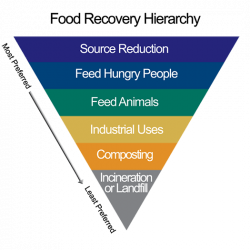Have you noticed all the talk about food waste lately? It seems like over the past couple months, the issue has been a lot more prevalent in the news, and for good reason. In August, the Natural Resources Defense Council (NRDC) released their food waste report titled, Wasted: How America Is Losing Up to 40 Percent of Its Food from Farm to Fork to Landfill. In this report, the NRDC states that 40 percent of food in the United States goes uneaten, and almost all of that ends up in the landfill. This is why we are so excited here at the IWRC to begin the Iowa Food Waste Reduction Project.
Last month, the IWRC was one of 19 recipients to receive funding from the Iowa Department of Natural Resources (DNR) Solid Waste Alternatives Program (SWAP) to implement this project (read more here). IWRC will be developing an educational campaign and online resource center to provide businesses and organizations with information on how to reduce and divert food waste currently being landfilled.
Why Food Waste
To begin with, food waste is the single largest component of U.S. municipal solid waste that is landfilled. And even before the NRDC report came out, the Iowa DNR released its 2011 Iowa Statewide Waste Characterization Study and can you guess the number one category for municipal solid waste in Iowa? If you guessed food waste, you’d be correct. It accounts for 13.3% of all landfilled waste in Iowa. Aside from the excess materials landfilled, if the U.S. is wasting 40% of its food, we’re also wasting the resources that went into creating that 40%. The NRDC report states that food waste ends up rotting in landfills accounting for almost 25% of U.S. methane emissions. In addition, we can also consider the chemicals, energy, and land used for its production as waste. All of that does not even consider the hunger epidemic that affects not only the U.S., but the entire world. At a time when resources are vital, 40% of food should not be wasted.
So What Can Be Done
 As with any issue, the initial focus relies on education. For the Iowa Food Waste Reduction Project, the IWRC is going to focus on educating large food waste producers such as community colleges, hospitals, and retirement communities. IWRC will use the U.S. EPA and USDA’s food recovery hierarchy to develop and prioritize food waste reduction options initially focusing on reduction at the source (i.e. with the larger producers of food waste), and secondly divert the food waste from Iowa landfills to alternative reuse efforts.
As with any issue, the initial focus relies on education. For the Iowa Food Waste Reduction Project, the IWRC is going to focus on educating large food waste producers such as community colleges, hospitals, and retirement communities. IWRC will use the U.S. EPA and USDA’s food recovery hierarchy to develop and prioritize food waste reduction options initially focusing on reduction at the source (i.e. with the larger producers of food waste), and secondly divert the food waste from Iowa landfills to alternative reuse efforts.
This project will officially begin in 2013 and we will keep you posted with updates as the project progresses.

